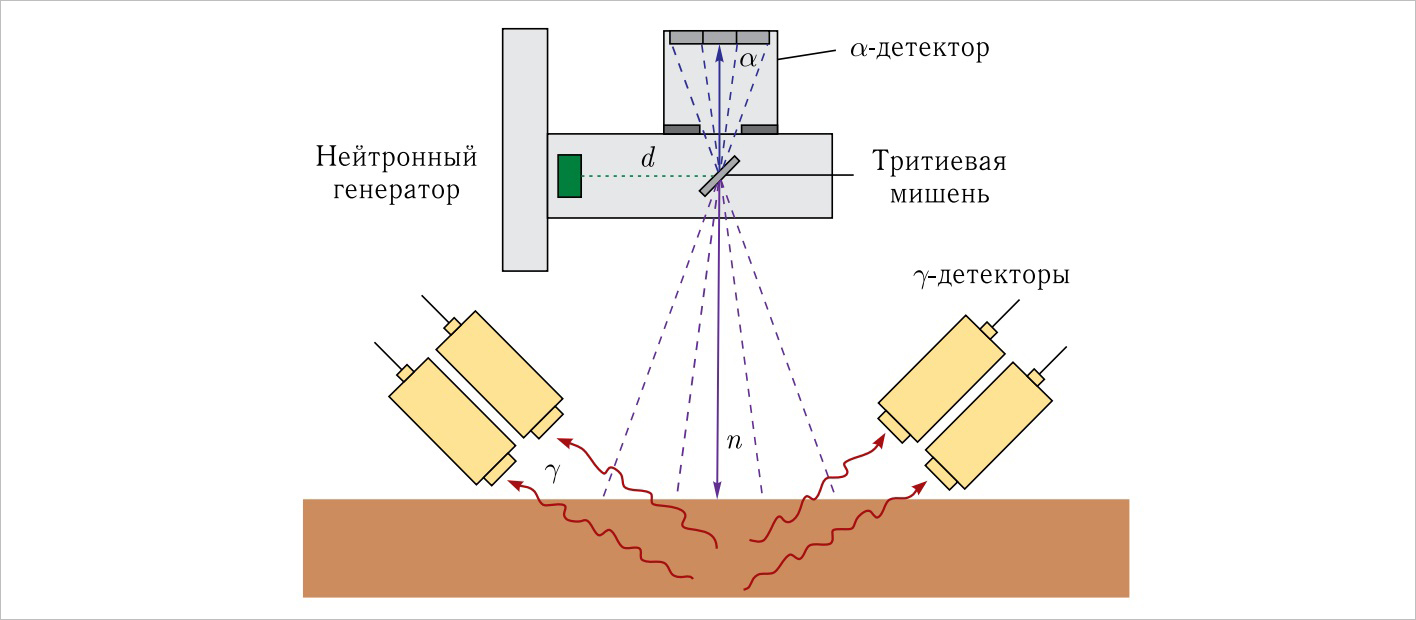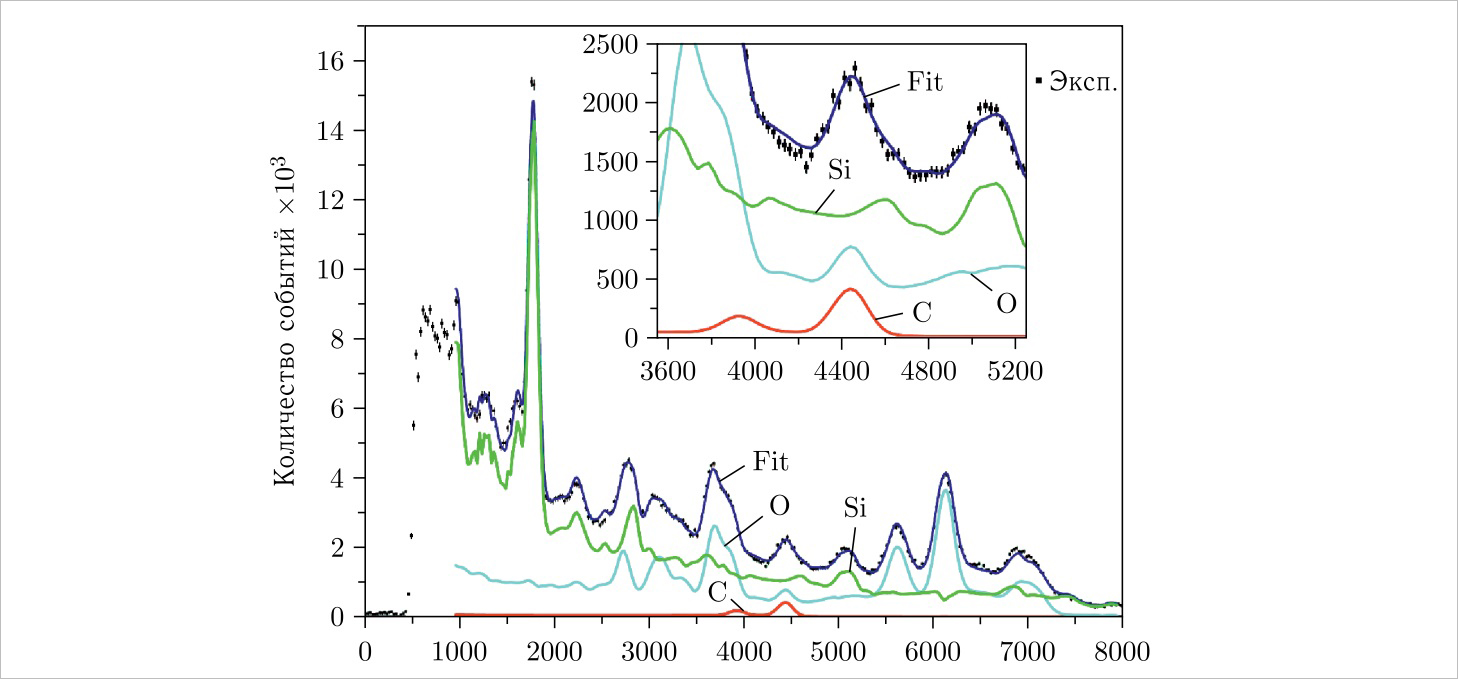Tagged neutron method: greenhouse effect measurement, search for diamonds, and fundamental science
News, 14 June 2023
Since 2014, JINR has been developing the interlaboratory TANGRA Project (TAgged Neutrons and Gаmma RAys) with facilities based on the tagged neutron method (TNM). As part of the project, specialists are working on a prototype of a mobile device for soil carbon analysis. Experts are going to use this tool at carbon test sites, special territories for the development and testing of technologies for measuring emissions and absorption of greenhouse gases.
The tagged neutron method was created in the 60s. However, it was not widely used at the time as specialists could only obtain neutrons at stationary equipment installed at accelerators. In the 2000s, TNM received a new impetus after the creation of the first compact portable neutron generator that produced tagged neutrons. For reference, an accelerator at the Laboratory of Neutron Physics at JINR, which was used for the first experiments to study TNM, occupies a six floor tower. A portable neutron generator, on the other hand, has a size of 30 cm and weighs 8 kg.
What are neutrons tagged with?
Two hydrogen isotopes collide in the portable neutron generator. Deuterons accelerated up to about 100 keV collide with a tritium target and produce 14 MeV neutrons. A deuterium-tritium reaction produces not only a neutron, but also an alpha particle (a nucleus of the 4He helium atom) that travels in the opposite direction to the neutron at almost 180°.
“If researchers manage to register the α-particle, they can determine the direction in which the neutron produced together with it goes. This is called neutron tagging. In a substance, a tagged neutron induces inelastic scattering reactions, in which a nucleus is de-excited by gamma quanta emission. The energy spectrum of each element’s γ-quanta is unique, and, like fingerprints, allows identifying the element,” Chief Researcher at the Laboratory of High Energy Physics at JINR, a TANGRA Collaboration participant Mikhail Sapozhnikov explained the essence of the method.
 Fig. 1. General scheme of the tagged neutron method
Fig. 1. General scheme of the tagged neutron method
Scintillation gamma detectors, devices that emit light when exposed to ionising radiation, register gamma quanta. Specialists determine elements’ relative concentrations in the substance by the ratio between peak intensities in the gamma-quantum spectrum.
TNM serves as a tool for 3D object location inside a solid. For example, specialists can find the exact location of a diamond in a piece of kimberlite and even determine its size. The most remarkable property of TNM is that it allows obtaining information about the third spatial coordinate along the neutron trajectory direction. To do this, specialists determine the time of flight between the moment when an α-particle reaches the alpha-detector and the moment when a gamma quantum from the object reaches the corresponding gamma detector. Having found out the time of flight, it is possible to calculate the distance to the point where the γ-quantum is emitted since the neutron velocity is the same and equals 5 cm/ns,” Mikhail Sapozhnikov explained.
“Usual neutron sources emit them in all directions, like a usual light bulb emits photons. Thanks to the tagged neutron method, specialists irradiate an object with a set of narrow neutron beams, similar to how they would with laser pointers,” the scientist added.
TNM’s advantage as compared with many other elemental analysis methods is its remote, non-destructive nature requiring no sample preparation such as, for example, cleaning, drying, or grinding the sample.
Fundamental research
Deputy Director for Scientific Work of the Laboratory of Neutron Physics at JINR and TANGRA Project Head Yuri Kopach noted that solutions for fundamental tasks of the project help conduct applied research with high accuracy. The fundamental part of TANGRA included, firstly, measuring an inelastic neutron scattering reaction with fast neutrons on various nuclei. The inelastic neutron scattering occurs when a neutron, usually with an energy of several MeV, hits and excites a nucleus, which then emits the neutron at a lower energy. In this kind of reaction, the neutron gives part of its energy to the nucleus. The excited nucleus, in turn, emits gamma quanta or other particles.
“To effectively implement this method, it is necessary to know the energies of the characteristic gamma quanta for each element and the chances of their emission. Assessing these chances is one of the tasks of the project entitled “Development of a method for position-sensitive neutron-gamma element analysis”. This project was among the winners of the 2023 competition titled “Conducting fundamental research and exploratory studies by individual scientific groups” by Russian Science Foundation. The second direction of the TANGRA Project’s fundamental research is measuring angular correlations between neutrons and gamma quanta. The latter are emitted nonisotropically, i.e. spatially unevenly, and have some angular dependence on the direction of the incoming neutron,” Yuri Kopach explained.
Carbon test sites, fast neutrons
The task of soil carbon analysis is one of the practical applications of TNM that are currently under implementation. For this purpose, JINR partnered with Dubna’s Diamant Company, a TANGRA Collaboration participant that actively uses TNM for different tasks. Together with this commercial organization, the Institute will develop a prototype of a mobile facility to analyse soil in the field.
Currently, TNM serves as the practically only reliable and simple way to determine the mass concentration of chemical elements in large areas. While using stationary methods of chemical soil analysis, it is necessary to take samples in many places and average their results. “Still, the obtained data is unreliable, since we can only analyse part of the field. We hope our device will be able to provide complete data on the entire field. He added that specialists already use a prototype of a mobile setup on fast, but not tagged neutrons. “We are working on something similar,” the scientist explained.
Laboratory experiments by the TANFRA Project on the determination of carbon in soil showed encouraging results. “In a laboratory, we can determine the percentage of carbon content in the soil. However, we need to test this method on the prototype of the mobile setup to see how it will work in the field,” Yuri Kopach said. He explained that specialists would install a geopositioning system, since the greatest interest of soil scientists and agronomists is the study of carbon concentration in a large territory, albeit with less accuracy than in a small area. The main goal is to quickly take measurements over a large area. Soil scientists plan to join the research in the field to indicate territories for searching carbon and possibly other chemical elements.
In 2021, the Diamant Company already carried out pilot measurements in the field at one of the first Russian carbon test sites in the Kaluga Region. Researchers made sure that the facility could operate while moving in the field and assessed carbon concentration determination accuracy.
Based on the study to measure carbon content in the soil in a laboratory using TNM as part of TANGRA, the Physics of Elementary Particles and Atomic Nuclei, Letters journal published an article “Determination of carbon concentration in soil using the tagged neutron method” by V. Yu. Aleksakhin, E. A. Razinkov, Yu. N. Rogov, A. B. Sadovsky, M. G. Sapozhnikov, I. D. Dashkov, D. N. Grozdanov, Yu. N. Kopatch, V. R. Skoy, N. A. Fedorov. The article covers the capabilities of a prototype of the device for determining the elemental composition of soil by the tagged neutron method, presents the developed calibration procedure for the facility, and measurements of soil and calibration samples taken using both TNM and chemical analysis. The latter can be considered a reference method to determine a sample’s chemical composition. However, the sample needs to be prepared by grinding it into practically powder. For carbon mass concentration, researchers obtained values of concentration measurement accuracy with the help of the new method.
 Fig. 2. Energy spectrum of γ-quanta of soil sample. The points show experimental data. Different colours indicate the contributions of the energy spectra of individual elements. The blue line shows the contribution of oxygen, the green one shows the contribution of silicon, and the red one shows the contribution of carbon. The dark-blue line shows the total contribution of all elements
Fig. 2. Energy spectrum of γ-quanta of soil sample. The points show experimental data. Different colours indicate the contributions of the energy spectra of individual elements. The blue line shows the contribution of oxygen, the green one shows the contribution of silicon, and the red one shows the contribution of carbon. The dark-blue line shows the total contribution of all elements
Analysis of rocks and dangerous cargoes. Other applications of TNM
In addition to obtaining measurements to solve the global warming problem, specialists could use TNM for various industrial applications. The method allows determining the content of 24 elements of the Mendeleev’s Periodic Table, such as Na, Mg, C, N, O, F, Al, Si, P, S, Cl, K, Ca, Ti, Cr, Mn, Fe, Ni, Cu, Zn, Zr, Pb, Sn, Bi. It is these elements that give pronounced peaks formed by the energy spectra of γ-quanta.
TNM turned out to be in great demand in the metallurgical, coal, and cement industries. In all these areas, specialists collected samples and carried out their subsequent chemical analysis to control raw materials on the conveyor, which took at least several hours. Conveyor TNM analysers allow experts to get information on the elemental composition of raw materials on the conveyor every minute with no sampling.
In the USA, the method was used even to carry out an elemental analysis of animals and humans in vivo. Thus, experts at the Brookhaven National Laboratory irradiated 20 volunteers at eight points of the body, measuring the concentration of nitrogen, carbon, and other elements in the human body. Specialists analyse the body composition to assess the physical development of a person, their adaptation to the environment, and the conditions of professional and sports activities, such as extreme sports, work at hypogravity, hypoxia, insufficient insolation, etc. In clinical medicine, the study of body composition is associated with the diagnosis and evaluation of the effectiveness of the treatment of certain diseases, such as obesity and osteoporosis.